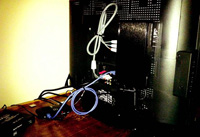Coaxing More Out of Coax


|
| The Multimedia over Coax Alliance (MoCA) is a universal standard for home entertainment networking. It covers all three pay TV segments: cable, satellite and IPTV. More information for installers at http://www.moca4installers.com |
Keith Harrison uses MoCA to speed deployment and improve the profitability of his retrofit projects. Frank Montensinos and Rich Green both see value in MoCA for their residential businesses.
MoCA?
It’s all about connectivity. And at the Consumer Electronics Show 2012 earlier this year, one of the areas where connectivity stood out was the connected home, specifically related to shared entertainment.
MoCA, short for the Multimedia over Coax Alliance, one of seemingly hundreds of alliances and trade groups promoting their technology approach, is basically a standard that uses coaxial cables to connect consumer electronics and home networking devices. It allows both data communication and the transfer of audio and video streams. MoCA may not necessarily be today’s consumer buzzword; it’s a technology that homeowners don’t hear about. But, for some manufacturers and electronic system contractors (ESCs), MoCA is catching on as a choice for home entertainment networking.
Coaxial connections are common in most homes today, used by the cable, IPTV and satellite providers as a means of delivering high quality video through set-top boxes and into television sets. Coax offers high capacity and low latency and is shielded from noise and interference, especially when compared to wireless. Coax also works across the various platforms — cable, telco/IPTV and satellite — and can also allow communications among some other connected home devices.
At CES 2012, for example, Broadcom of Irvine, Calif., showcased the industry’s first MoCA 2.0 integrated portfolio, including six new set-top boxes and hybrid IP gateway system-on-a-chip platforms. MoCA 2.0 more than doubles home network performance and enhances the quality of video distribution in the home. It also enables more energy efficient systems and supports higher levels of security for enhanced content protection.
So what is MoCA’s charm for ESCs? According to Rob Gelphman, the alliance’s chair, marketing work group, “When you consider a home networking narrative, there are four ingredients that are really required: Mobility, ubiquity, ease of use and reliability. Wireless and mobility go hand in hand. Ubiquity is powerline and maybe wireless.” When it comes to ease of use, Gelphman believes that, if it is hard to use but free, that solution may not matter. “But with video becoming the killer app, reliability moves to the top. The best medium for home video is coax. MoCA owns reliability.”
Green, president and chief executive officer, Rich Green Design, Palo Alta, Calif., kind of agrees. MoCA is a go-to alternative for him. “If I don’t have a CAT 5 or 6 infrastructure, then there is MoCA. After that it’s powerline.” He sees numerous hybrid solutions as technology reaches into every nook of the home. But “wireless may be the ultimate end game.”

|
| Keith Harrison’s Total Home Technologies team uses MoCA technology to speed deployment and improve the profitability of the retrofit projects which comprise over half of the company’s business. |
Montensinos, president, ICAV, with locations in Queens and Suffolk, N.Y., uses MoCA technology adapters, among other gear, and points out that there is no doubt that “we are in the day when Internet connections are essential.” And with some homeowners placing less emphasis on one centralized home theater, “the increased expectation of multi-room audio video” plays to the features of MoCA.
Harrison, owner/operator and founder of Total Home Technologies, Roseland, N.J., has become increasingly focused on retrofit services. MoCA technology has become a valuable tool that he uses to take full advantage of the “pre-wiring” available in most of his clients' homes. While his crews usually have to pull some additional wiring to tie together the system's main components in a central location, they still make heavy use of MoCA adapters to deliver Ethernet connections wherever they are needed.
Eliminating most of the uncertainties involved with new wire pulls allows Harrison to be more confident when bidding a job and helps his team complete most of these jobs with a two-person crew in four to five working days.
One central media distribution center built by Total Home Technologies ties together several set-top boxes, Blue Ray players, an audio/video server, and home automation equipment using a high performance, VLAN-capable router.
The ability of MoCA certified products to help keep a project on-schedule and on budget came in especially handy on a recent job where Harrison ran into several challenges while adding a basic home entertainment and automation system (distributed audio/video, smart lighting, and HVAC controls) including security to a customer's home. It was a large, two-story building, with a finished basement, a big garage, and pre-wired with Siamese cable (dual coax plus CAT 5) in a home-run configuration that terminated in the basement mechanical room. Harrison's team took advantage of the existing cabling and installed a rack to house several set-top boxes, a DVE/CD changer, a media server and an 8X8 video distribution switch.
They also replaced the gigabit passive optical network or GPON operator's consumer-grade Ethernet router with a business-class unit that would reliably support virtual private network or VPN services and multiple HD video streams the new system would be running.
Despite the home's abundant pre-wiring, the existing cables still did not provide enough connections to deliver the multiple system operator’s (MSO) video programming, video from the central media sources, audio streams and remote control signals to every room. Harrison solved part of the problem by delivering locally-sourced HD digital video over one of the CAT 5 pairs using digital baluns. Since only the den and a couple of other rooms had existing speaker wires, the second coax was used to deliver central audio to the remainder of the house. This left several major issues to be solved. For one thing, Harrison needed a connection for a Control4 home automation system's in-room control box, which normally requires a separate CAT 5 run. Instead, Harrison used the Siamese cable's coax cable and a MoCA adapter to derive an Ethernet port in the rooms where it was needed. Using MoCA to light up the home's coax also solved the problem of providing Ethernet connections for any Internet-enabled TVs or in-room media players.

|
| In a Total Home Technologies installation, media from the home’s central video system is delivered using an HDMI balun (box at left) over existing twisted pair cabling while a MoCA coax adapter (lower middle) provides a channel for the central control’s infrared remote (box on back of TV) and an Internet connection. |
For example, adding a MoCA adapter and a switch in the den provided Ethernet connections for the mini-theater's new HDTV and home automation box, as well as the owner's existing surround sound receiver and networked gaming system.
Media from the home's central video system is delivered using an HDMI balun over existing twisted pair cabling while a MoCA coax adapter provides a channel for the central control's infrared remote and an Internet connection.
By taking full advantage of the existing Siamese cable plant with a combination of HDMI baluns and MoCA coax adapters, the two-man Total Home Technologies crew was able to wire a large home with high definition IP video service, home automation, central audio and security without cutting a single new hole. By knocking at least three working day’s worth of wire pulls from the install team's workload, MoCA technology and products helped the firm complete a $55,000 project in one working week.
Looking for a reprint of this article?
From high-res PDFs to custom plaques, order your copy today!




